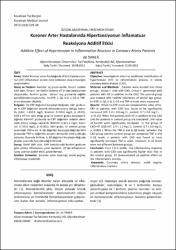Koroner arter hastalarında hipertansiyonun inflamatuar reaksiyona additif etkisi
Özet
Amaç: Stabil koroner arter hastalığında (KAH) hipertansiyonun
(HT) inflamatuar sürece ilave katkısının olup olmadığını
araştırmaktır.
Gereç ve Yöntem: Hastalar üç gruba ayrıldı; Grup I sadece
KAH olan, Grup II ise KAH’a ilaveten HT’si olan hastalardan
oluşturuldu. Kontrol grubu benzer yaş grubunda sağlıklı
gönüllülerden oluşturuldu. hs-CRP, IL-1β, IL-6, IL-10 ve TNF-
α’nın düzeyleri ölçüldü.
Bulgular: hs-CRP değerleri karşılaştırıldığında, KAH grubunda
hs-CRP değerinin anlamlı derecede artmış olduğu bulundu
(KAH: 1.4±0.8 mg/L, Kontrol: 0.7±0.6 mg/L, p <0.01).
KAH’a HT’nin eşlik ettiği grup ile kontrol grubu karşılaştırıldığında
KAH+HT grubunda hs-CRP değerinin anlamlı derecede
artmış olduğu saptandı (KAH+HT:1.9±1.2 mg/L, Kontrol:
0.7±0.6 mg/L, p <0.001). KAH grubu ile kontrol grubu
arasındaki TNF-α ve IL-1β değerleri karşılaştırıldığında KAH
grubunda TNF-α değerinin anlamlı derecede artmış olduğu
bulundu. Bununla birlikte, IL-10 değerleri karşılaştırıldığında
gruplar arasında fark olmadığı belirlendi.
Sonuç: Stabil dahi olsa, KAH hastalarında kontrol grubuna
göre artmış inflamatuar yanıt saptandı. HT’nin inflamatuar
süreç üzerine additif etkisi gösterilemedi. Objective: Investigation about an additional contribution of
hypertension (HT) to inflammatory process in stable
coronary artery disease (CAD).
Material and Methods: Patients were divided into three
groups . Group I only with CAD, Group II generated with
patients with HT in addition to the CAD. The control group
was created with healthy volunteers of similar age group.
hs-CRP, IL-1β, IL-6, IL-10 and TNF-α levels were measured.
Results: When hs-CRP levels are compared the value of hsCRP
in patients with CAD was found to be significantly
increased (HR: 1.4 ± 0.8 mg / L , control: 0.7 ± 0.6 mg / L ,
p <0.01). When the patients with HT in addition to the CAD
and the patients in control group are compared , the value
of hs-CRP were significantly increased in the group of
CAD+HT (CAD+HT: 1.9 ± 1.2 mg / L, Control: 0.7 ± 0.6 mg /L,
p <0.001 ). When the TNF-α and IL-1β levels between the
CAD group and the control group are compared TNF-α and
IL-1β levels in patients with CAD was found to have
significantly increased TNF-α value. However, IL-10 levels
were not different between groups.
Conclusion: Even if it is stable, the inflammatory response
in patients with CAD was significantly higher than that in
the control group. HT demonstrated an additive effect on
the inflammatory process.
Kaynak
Afyon Kocatepe Üniversitesi, Kocatepe Tıp DergisiCilt
14Sayı
3Bağlantı
http://hdl.handle.net/11630/2031Koleksiyonlar
- Makaleler [452]
- TR-Dizin İndeksli Yayınlar Koleksiyonu [548]



















